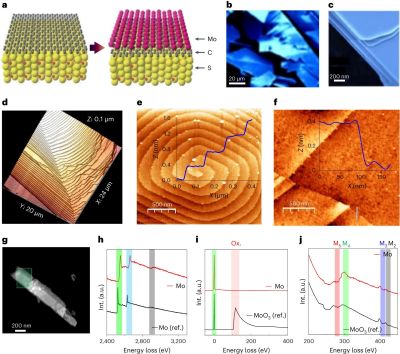Amidst all the (well-deserved) hype around graphene, it’s important to remember that its properties are not unique to carbon. More atoms can be coaxed into stable 2-dimensional configuration, with molybdenene previously theoretically possible. This is now demonstrated by Tumesh Kumar Sahu and colleagues in a recent Nature Nanotechnology article, through the manufacturing of a 2D molybdenum-based material which they showed to be indeed molybdenene. Essentially, this is a 2D lattice of molybdenum atoms, a configuration in which it qualifies as Dirac matter, just like graphene. For those of us unfamiliar with Dirac materials, this gentle introduction by Jérôme Cayssol in Comptes Rendus Physique might be of use.

In order to create molybdenene, the researchers started with molybdenum disulfide (MoS2), which using a microwave-assisted field underwent electrochemical transformation into whiskers that when examined turned out to consist out of monolayers of Mo. The sulfur atoms were separated using a graphene sheet. As is typical, molybdenene sheets were exfoliated using Scotch tape, in a process reminiscent of the early days of graphene research.
Much like graphene and other Dirac materials, molybdenene has many potential uses as a catalyst, as cantilever in scanning electron microscope (SEM) tips, and more. If the past decades of research into graphene has demonstrated anything, it is that what once seemed more of a novelty, suddenly turned out to have endless potential in fields nobody had considered previously. One of these being as coatings for hard disk platters, for example, which has become feasible due to increasingly more efficient ways to produce graphene in large quantities.















“If the past decades of research into graphene has demonstrated anything, it is that what once seemed more of a novelty, suddenly turned out to have endless potential in fields nobody had considered previously.”
Science and technology have a way of doing that.
Take the Hall effect: https://en.wikipedia.org/wiki/Hall_effect
Discovered and demonstrated back in 1879, it originally took a lab full of expensive equipment to provoke and measure it.
These days, you can buy a simple three pin device that detects the strength of a magnetic field using the Hall effect – and it’ll literally cost just pennies.
You can never tell what will come of a discovery. Maybe nothing, maybe something that changes the world.
The “gentle introduction” was like drowning in maple syrup as opposed to drowning in sulfuric acid.
Ok, now that’s a weird comparison. 😂
But it’s good for visualizing it in front of the mental eye. 🙂👍
Exactly 🤣
Do you mean “cantilever in atomic force microscopy (AFM) tips”?
You know what would go well together? Manganese and Sodium. The crystal structure would go:
MnMnNa
Do doo de do do…
I LOL’d a bit too hard on that one… TY!
Also known as sodium slim shady.
“scanning electron microscope” 🙄
That’s a “Rasterelektronenmikroskop”, a German invention.